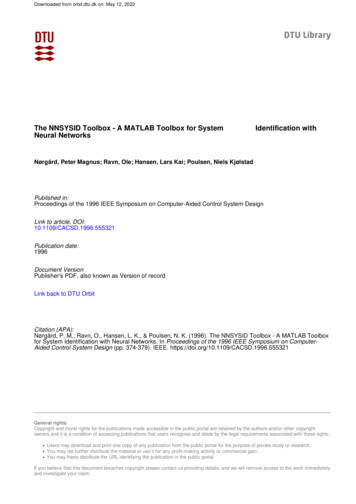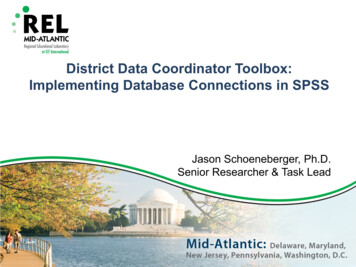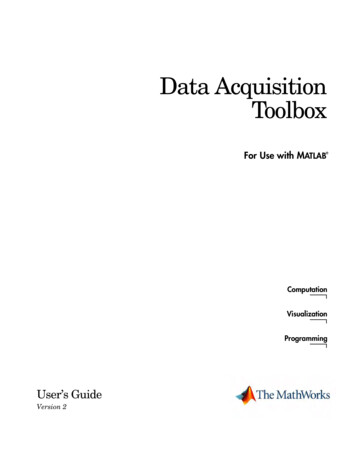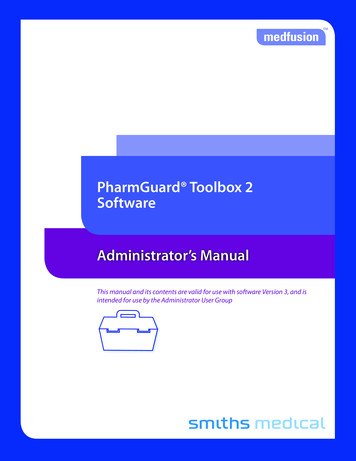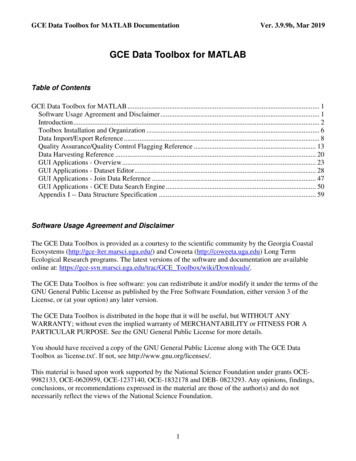
Transcription
District Data Coordinator Toolbox:Automating Data Acquisition Using DatabaseConnections in SASJason Schoeneberger, Ph.D.Senior Researcher & Task Lead
PrerequisiteFor this presentation, we assume you have anestablished database connection.If not, please review the tool below, which isavailable on the REL Mid-Atlantic website:District Data Coordinator Toolbox:Implementing Database Connectionsin Excel2
Taking the next step You’re making use of a database connection(s) inSAS, and your increased efficiency resulted inmore data requests from stakeholders Let us suppose some of those data needs arerepetitive, or cyclical in nature– Maybe someone wants a report updated on a monthly orweekly basis– Maybe data in the database is refreshed each evening,and you want the latest available to you each morning Let’s automate that data acquisition process!3
Road map to data connectivityStep 3.Schedule task with TaskSchedulerStep 2.Create batch file toexecute SASStep 1.Create SAS syntaxfile4
Our road map to automation1. We prepare an SAS syntax file to generate whatwe need2. A batch file is created containing instructions totell our computer to execute our SAS Program3. Then we schedule a task (running the batch file)using the Task Scheduler5
Traveling the road by example To follow the steps in our road map to connectivity,let’s assume the following example:– District leadership is focused on monitoring studentmobility– As a result, several principals with highly-mobilepopulations have requested a weekly summary report ofenrollment at their middle schools– They want to examine enrollment, disaggregated bygrade level and student race/ethnicity– The data we need to obtain are stored in an Accessdatabase6
Report to be automated Below is the table we want to automatically refresheach week.7
Using SAS syntax To automate the refresh of our table, we need touse SAS syntax to accomplish our tasks8
Compiling SAS commands in syntax form1. Obtain data to work with from database query2. Analyze or manipulate data in logical order to generatedesired results (here, a crosstab table)3. Save output (as HTML output in desired path)1329
Save syntax file1.2.3.4.5.Click File in the syntax window1Click Save As Navigate to folder location 2Name syntax fileClick Save 34510
Creating a batch file Using Notepad or another text editor, we cancreate a batch (.bat extension) file containinginstructions informing our computer to execute ourSAS program file11
Opening Notepad1.2.3.4.Click on the Windows iconClick All Programs3Click on AccessoriesClick on Notepad42112
Batch file code for copy-pasting Below is the code to be copy-pasted into the batch file All code should be on a single line"c:\program files\SASHome\SASFoundation\9.4\sas.exe" -batch -sysin"C:\Users\Jason\SharePoint\Schoeneberger, Jason\technical track\odbc connection\sasautomate.sas" -log "C:\Users\Jason\SharePoint\Schoeneberger, Jason\technicaltrack\odbc connection\sas eth grade.log" –print"C:\Users\Jason\SharePoint\Schoeneberger, Jason\technical track\odbcconnection\sas eth grade.lst"13
Creating the batch file1. Specify the SAS executable path on your machine2. Specify the path for the saved SAS program3. Specify the paths for the SAS log and output files1234. Click File5. Click Save As4514
Saving the batch file1. Navigate to your chosen folder2. Name your batch file (sas gd eth batch), and enter ‘.bat’as the file extension3. Click Save4. CloseNotepad412315
Saving the batch file1. Verify batch file was saved2. You can check that it works by double-clicking on thebatch file itself3. You should see SAS open briefly, then immediately close4. If there is an error in the code, you may get an error notice2116
Scheduling a task Now we can use the Task Scheduler to run ourbatch file, which executes the SAS syntax file andrefreshes our output crosstab table17
Opening Task Scheduler1. Enter ‘Task Scheduler’ in search box2. Click on Action in the Task Scheduler window3. Select Create Basic Task12318
Naming the scheduled task1. Enter a name for the scheduled task(e.g gd eth sas refresh)2. Click Next1219
Set frequency of scheduled task1. Select how often you would like the refresh to occur(e.g. a weekly refresh for our principals in this example)12. Click Next220
Set time-of-day and recurrence ofscheduled task1. Specify the date to begin and time of day you would liketo use2. Specify the day of the week (e.g Monday) you want therefresh to occur3. Click Next12321
Specify the type of action to be scheduled1. Select ‘Start a program’2. Click Next1222
Specify file scheduled task should execute1. Click ‘Browse’ to navigate to folder location where ‘.bat’file is stored123
Specify batch file to execute1. Navigate to folder location where ‘.bat’ file is stored2. Select the ‘.bat’ file of interest13. Click Open2324
Specify file scheduled task should execute1. Click Next125
Review & finish scheduling task1. Review properties of scheduled task:a) Name of scheduled taskb) Trigger timec) Action (batchfile to execute)1a2. Click Finish1b21c26
Monitoring/editing a scheduled task1. Double-click on the scheduled task under the ActiveTasks pane inside Task Scheduler:127
Monitoring/editing a scheduled task1. Click on the scheduled task under the Action Pane insideTask Scheduler:122. Click on Action on the menu bar–From here you can run, end, disable,delete and view the properties33. Click on Properties to change theday, time or recurrence settings28
Monitoring/editing a scheduled task1. Using the tabs across the top of the Properties pane, youcan edit various aspects of the scheduled task2. On a particulartab, click Edit tochange detailsabout thescheduled task3. Click OK whenfinished editing12329
Alignment of task trigger and file time stamp1. Note trigger of 4:25 PM on Mondays2. Note time stamp on file when scheduled task runs1230
Potential problems If time stamp on file fails to update – On initial use, check code in .bat file to ensure no errors weremade in copy-paste– Was your computer inadvertently shut-down or powered-down atthe scheduled time?– Was the server or machine where database source is locatedinadvertently shut-down or power-down at the scheduled time?– Have there been any changes to the database source (e.g. AccessSQL), such as table name changes, connection informationchange (path or server name)?31
Questions/Need helpContact:Jason Schoeneberger, Ph.D.Senior Researcher and Task LeadREL Mid-Atlantic at ICF 395Please visit www.relmidatlantic.org for other datatools!32
District Data Coordinator Toolbox: Automating Data Acquisition Using Database Connections in SAS Author: REL Mid-Atlantic Subject: Automating Data Acquisition Using Database Connections in SAS Keywords: Automation, Data Acquisition, Dat
